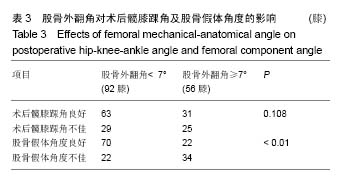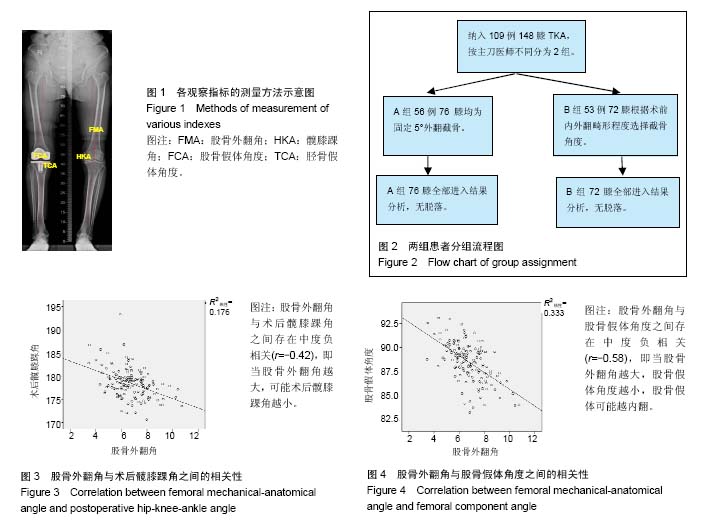| [1] Parratte S, Pagnano MW, Trousdale RT, et al. Effect of postoperative mechanical axis alignment on the fifteen-year survival of modern, cemented total knee replacements. J Bone Joint Surg Am. 2010;92(12): 2143-2149.[2] Vanlommel L, Vanlommel J, Claes S, et al. Slight undercorrection following total knee arthroplasty results in superior clinical outcomes in varus knees. Knee Surg Sports Traumatol Arthrosc. 2013; 21(10): 2325-2330.[3] Bellemans J. Neutral mechanical alignment: a requirement for successful TKA: opposes. Orthopedics.2011;34(9): e507-509.[4] Bellemans J, Colyn W, Vandenneucker H, et al. The Chitranjan Ranawat award: is neutral mechanical alignment normal for all patients? The concept of constitutional varus. Clin Orthop Relat Res. 2012;470(1): 45-53.[5] Fang DM, Ritter MA, Davis KE. Coronal alignment in total knee arthroplasty: just how important is it. J Arthroplasty. 2009;24(6 Suppl): 39-43.[6] Berend ME, Ritter MA, Meding JB, et al. Tibial component failure mechanisms in total knee arthroplasty. Clin Orthop Relat Res. 2004;(428): 26-34.[7] Werner FW, Ayers DC, Maletsky LP, et al. The effect of valgus/varus malalignment on load distribution in total knee replacements. J Biomech. 2005;38(2):349-355.[8] Ritter MA, Davis KE, Meding JB, et al. The effect of alignment and BMI on failure of total knee replacement. J Bone Joint Surg Am. 2011;93(17):1588-1596.[9] Longstaff LM, Sloan K, Stamp N, et al. Good alignment after total knee arthroplasty leads to faster rehabilitation and better function. J Arthroplasty. 2009;24(4): 570-578.[10] Mason JB, Fehring TK, Estok R, et al. Meta-analysis of alignment outcomes in computer-assisted total knee arthroplasty surgery. J Arthroplasty. 2007;22(8): 1097-1106.[11] Thienpont E, Fennema P, Price A. Can technology improve alignment during knee arthroplasty. Knee. 2013;20 Suppl 1: S21-28.[12] Confalonieri N, Manzotti A, Pullen C, et al. Computer-assisted technique versus intramedullary and extramedullary alignment systems in total knee replacement: a radiological comparison. Acta Orthop Belg. 2005;71(6): 703-709.[13] Shah NA, Patil HG, Dhawale AS, et al. Limited femoral navigation versus conventional intramedullary femoral jig based instrumentation for achieving optimal restoration of mechanical axis post total knee arthroplasty: a prospective comparative study of 200 knees. J Arthroplasty. 2015;30(4): 559-563.[14] Voleti PB, Hamula MJ, Baldwin KD, et al. Current data do not support routine use of patient-specific instrumentation in total knee arthroplasty. J Arthroplasty. 2014;29(9):1709-1712.[15] Nam D, Nawabi DH, Cross MB, et al. Accelerometer-based computer navigation for performing the distal femoral resection in total knee arthroplasty. J Arthroplasty. 2012;27(9): 1717-1722.[16] Hasegawa M, Miyazaki S, Yamaguchi T, et al. Comparison of Midterm Outcomes of Minimally Invasive Computer-Assisted vs Minimally Invasive Jig-Based Total Knee Arthroplasty. J Arthroplasty. 2017;32(1): 43-46.[17] Bae DK, Song SJ, Park CH, et al. A Comparison of the Medium-Term Results of Total Knee Arthroplasty Using Computer-Assisted and Conventional Techniques to Treat Patients With Extraarticular Femoral Deformities. J Arthroplasty. 2017;32(1): 71-78.[18] Miyasaka T, Kurosaka D, Saito M, et al. Accuracy of Computed Tomography-Based Navigation-Assisted Total Knee Arthroplasty: Outlier Analysis. J Arthroplasty. 2017;32(1): 47-52.[19] Fujimoto E, Sasashige Y, Nakata K, et al. Technical Considerations and Accuracy Improvement of Accelerometer-Based Portable Computer Navigation for Performing Distal Femoral Resection in Total Knee Arthroplasty. J Arthroplasty. 2017;32(1): 53-60.[20] Liodakis E, Antoniou J, Zukor DJ, et al. Navigated vs Conventional Total Knee Arthroplasty: Is There a Difference in the Rate of Respiratory Complications and Transfusions. J Arthroplasty. 2016;31(10): 2273-2277.[21] Zhu M, Ang CL, Yeo SJ, et al. Minimally Invasive Computer-Assisted Total Knee Arthroplasty Compared With Conventional Total Knee Arthroplasty: A Prospective 9-Year Follow-Up. J Arthroplasty. 2016;31(5):1000-1004.[22] Nam D, Vajapey S, Haynes JA, et al. Does Use of a Variable Distal Femur Resection Angle Improve Radiographic Alignment in Primary Total Knee Arthroplasty. J Arthroplasty. 2016.[23] Bardakos N, Cil A, Thompson B, et al. Mechanical axis cannot be restored in total knee arthroplasty with a fixed valgus resection angle: a radiographic study. J Arthroplasty. 2007;22(6 Suppl 2): 85-89.[24] Shi X, Li H, Zhou Z, et al. Comparison of Postoperative Alignment Using Fixed vs Individual Valgus Correction Angle in Primary Total Knee Arthroplasty With Lateral Bowing Femur. J Arthroplasty. 2016;31(5): 976-983.[25] Davis JA, Hogan C, Dayton M. Postoperative Coronal Alignment After Total Knee Arthroplasty: Does Tailoring the Femoral Valgus Cut Angle Really Matter. J Arthroplasty. 2015; 30(8):1444-1448.[26] McGrory JE, Trousdale RT, Pagnano MW, et al. Preoperative hip to ankle radiographs in total knee arthroplasty. Clin Orthop Relat Res. 2002;(404):196-202.[27] Kharwadkar N, Kent RE, Sharara KH, et al. 5 degrees to 6 degrees of distal femoral cut for uncomplicated primary total knee arthroplasty: is it safe. Knee. 2006;13(1): 57-60.[28] Deakin AH, Basanagoudar PL, Nunag P, et al. Natural distribution of the femoral mechanical-anatomical angle in an osteoarthritic population and its relevance to total knee arthroplasty. Knee. 2012;19(2): 120-123.[29] Nam D, Maher PA, Robles A, et al. Variability in the relationship between the distal femoral mechanical and anatomical axes in patients undergoing primary total knee arthroplasty. J Arthroplasty. 2013;28(5): 798-801.[30] Oswald MH, Jakob RP, Schneider E, et al. Radiological analysis of normal axial alignment of femur and tibia in view of total knee arthroplasty. J Arthroplasty. 1993;8(4): 419-426.[31] Moreland JR, Bassett LW, Hanker GJ. Radiographic analysis of the axial alignment of the lower extremity. J Bone Joint Surg Am. 1987;69(5): 745-749.[32] Huang TW, Lee CY, Lin SJ, et al. The Influence of Alignment on Midterm Outcome after Total Knee Arthroplasty in Patients With Marked Coronal Femoral Bowing. J Arthroplasty. 2015; 30(9):1531-1536.[33] Deakin AH, Sarungi M. A comparison of variable angle versus fixed angle distal femoral resection in primary total knee arthroplasty. J Arthroplasty. 2014;29(6): 1133-1137.[34] Meric G, Gracitelli GC, Aram LJ, et al. Variability in Distal Femoral Anatomy in Patients Undergoing Total Knee Arthroplasty: Measurements on 13,546 Computed Tomography Scans. J Arthroplasty. 2015;30(10): 1835-1838.[35] Yau WP, Chiu KY, Tang WM, et al. Coronal bowing of the femur and tibia in Chinese: its incidence and effects on total knee arthroplasty planning. J Orthop Surg (Hong Kong). 2007;15(1): 32-36.[36] SC Reed JG. The accuracy of femoral intramedullary guides in total knee arthroplasty. J Arthroplasty. 1997.[37] Xiao J, Wang C, Zhu L, et al. Improved method for planning intramedullary guiding rod entry point in total knee arthroplasty. Arch Orthop Trauma Surg. 2014;134(5): 693-698.[38] Swanson KE, Stocks GW, Warren PD, et al. Does axial limb rotation affect the alignment measurements in deformed limbs. Clin Orthop Relat Res. 2000;(371): 246-252. |
.jpg)



.jpg)